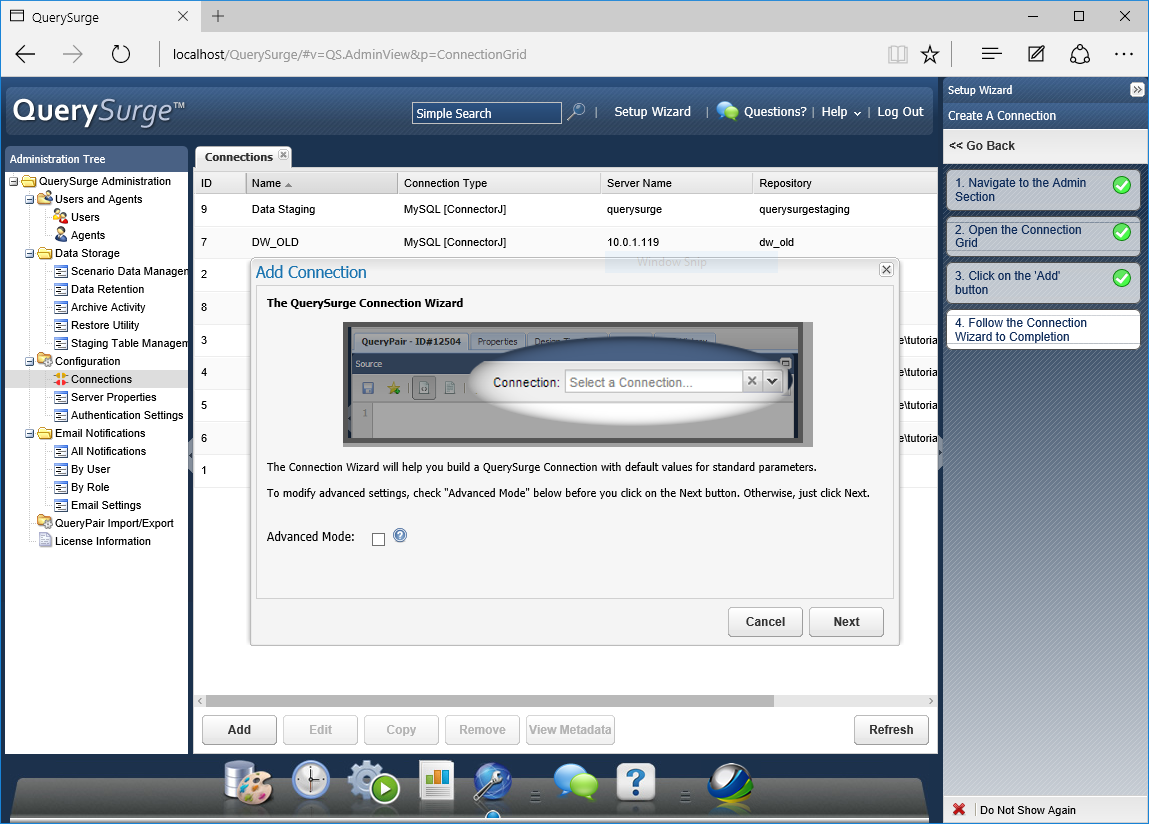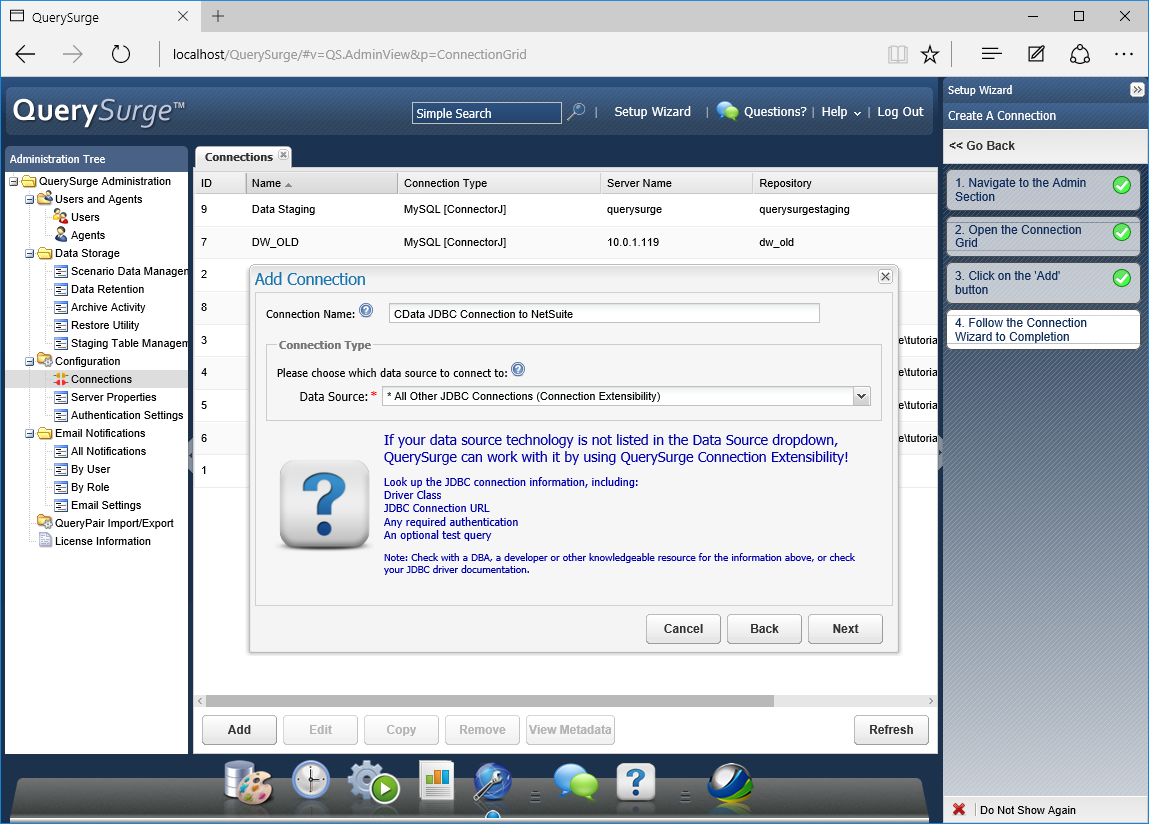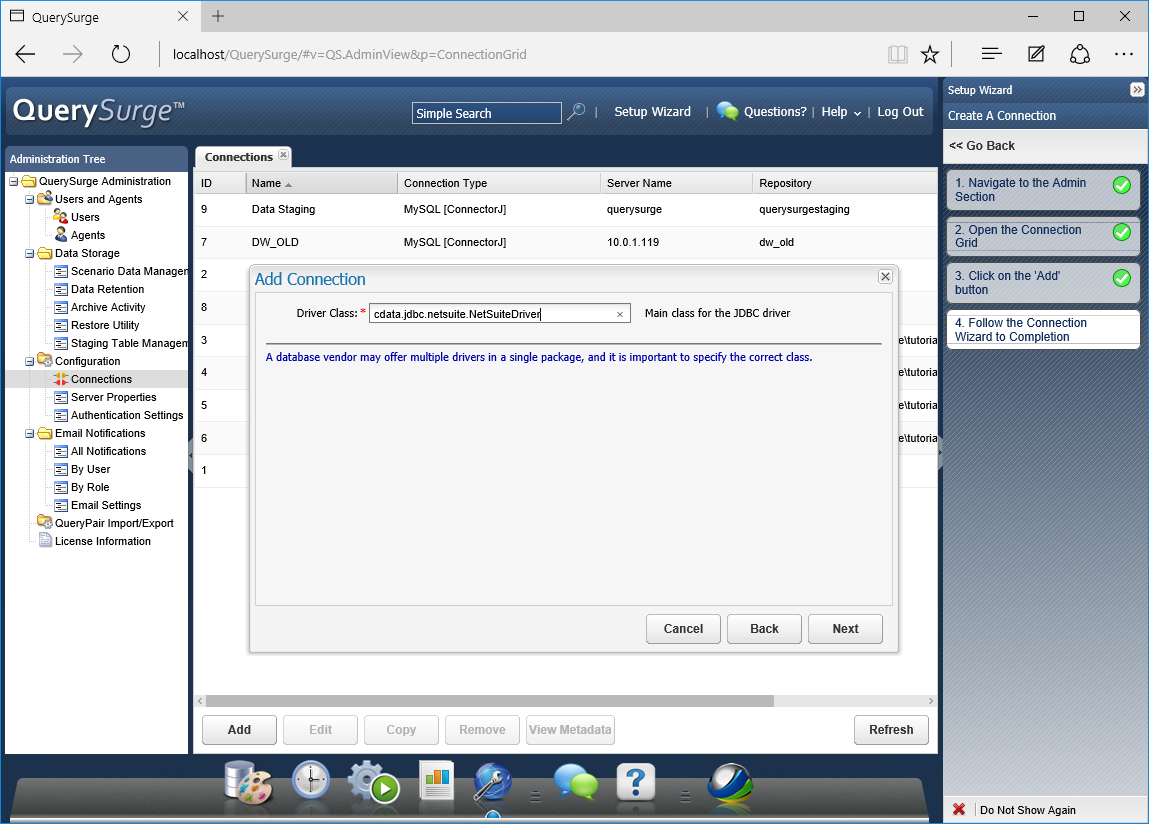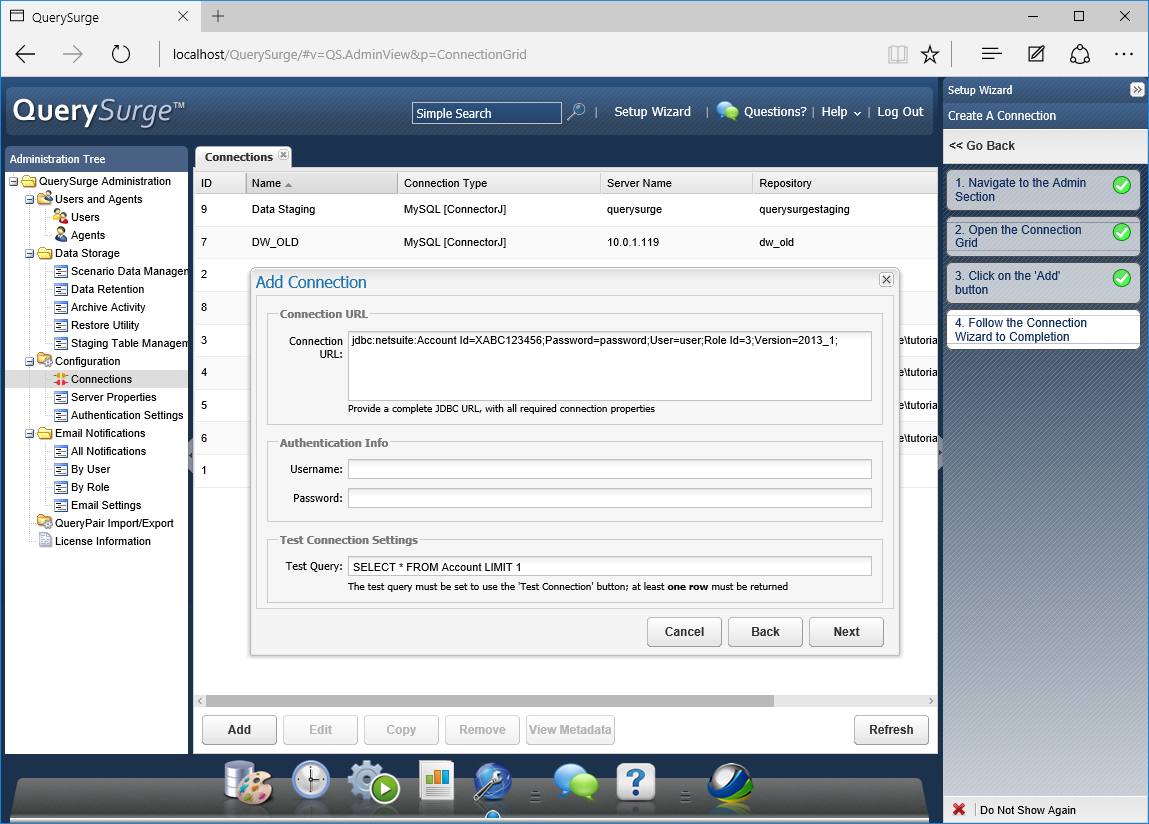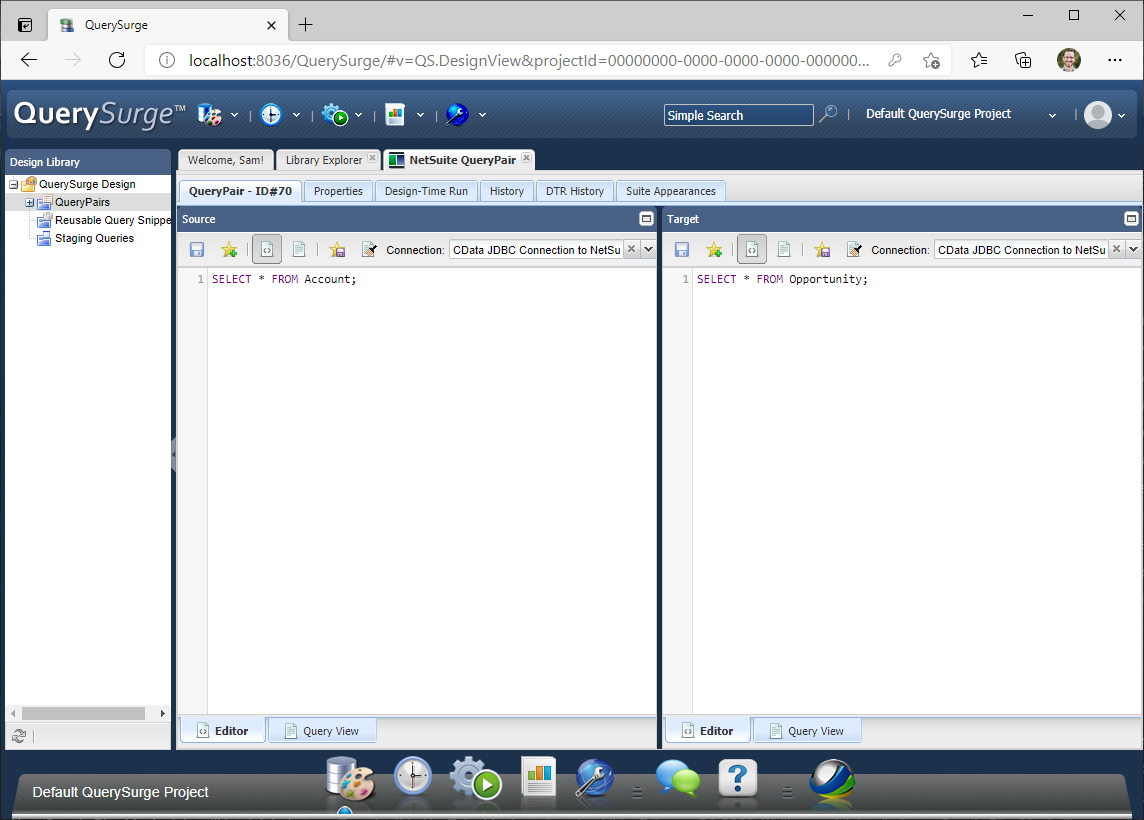Discover how a bimodal integration strategy can address the major data management challenges facing your organization today.
Get the Report →Validate Amazon Athena Data with QuerySurge
Access and validate Amazon Athena data in QuerySurge using the CData JDBC Driver.
QuerySurge is a smart data testing solution that automates data validation and testing. When paired with the CData JDBC Driver for Amazon Athena, QuerySurge can work with live Amazon Athena data. This article walks through connecting to Amazon Athena data from QuerySurge.
With built-in optimized data processing, the CData JDBC Driver offers unmatched performance for interacting with live Amazon Athena data. When you issue complex SQL queries to Amazon Athena, the driver pushes supported SQL operations, like filters and aggregations, directly to Amazon Athena and utilizes the embedded SQL engine to process unsupported operations client-side (often SQL functions and JOIN operations). Its built-in dynamic metadata querying allows you to work with and analyze Amazon Athena data using native data types.
Connecting to Amazon Athena Data in QuerySurge
To connect to live Amazon Athena data from QuerySurge, you need to deploy the JDBC Driver JAR file to your QuerySurge Agent(s) and add a new connection from the QuerySurge Admin view.
Deploy the JDBC Driver
- Download the CData JDBC Driver for Amazon Athena installer, unzip the package, and run the JAR file to install the driver.
- Once the driver is installed, stop the Agent Service.
- Copy the JAR File (and license file if it exists) from the installation location (typically C:\Program Files\CData\CData JDBC Driver for Amazon Athena\lib\) to your Agent(s) (QuerySurge_install_dir\agent\jdbc).
- Restart the Agent Service.
For more information on deploying JDBC drivers for QuerySurge, refer to the QuerySurge Knowledge Base.
Configure a New Connection to Amazon Athena
- Log into QuerySurge and navigate to the Admin view.
- Click Configuration -> Connections in the Administration Tree.
- Click Add to create a new connection.
- In the QuerySurge Connection Wizard, click Next.
![Creating a new connection]()
- Name the connection (e.g. CData JDBC Connection to Amazon Athena).
- Set the Data Source to "All Other JDBC Connections (Connection Extensibility)" and click Next.
![Naming the connection and choosing a Data Source]()
- Set the Driver Class to cdata.jdbc.amazonathena.AmazonAthenaDriver and click Next.
![Setting the Driver Class]()
Set the Connection URL using the necessary connection properties to authenticate with Amazon Athena. Your Connection URL will look something like the following:
jdbc:amazonathena:AccessKey='a123';SecretKey='s123';Region='IRELAND';Database='sampledb';S3StagingDirectory='s3://bucket/staging/';
Built-in Connection String Designer
For assistance in constructing the JDBC URL, use the connection string designer built into the Amazon Athena JDBC Driver. Either double-click the JAR file or execute the jar file from the command-line.
java -jar cdata.jdbc.amazonathena.jarFill in the connection properties and copy the connection string to the clipboard.
Authenticating to Amazon Athena
To authorize Amazon Athena requests, provide the credentials for an administrator account or for an IAM user with custom permissions: Set AccessKey to the access key Id. Set SecretKey to the secret access key.
Note: Though you can connect as the AWS account administrator, it is recommended to use IAM user credentials to access AWS services.
Obtaining the Access Key
To obtain the credentials for an IAM user, follow the steps below:
- Sign into the IAM console.
- In the navigation pane, select Users.
- To create or manage the access keys for a user, select the user and then select the Security Credentials tab.
To obtain the credentials for your AWS root account, follow the steps below:
- Sign into the AWS Management console with the credentials for your root account.
- Select your account name or number and select My Security Credentials in the menu that is displayed.
- Click Continue to Security Credentials and expand the Access Keys section to manage or create root account access keys.
Authenticating from an EC2 Instance
If you are using the CData Data Provider for Amazon Athena 2018 from an EC2 Instance and have an IAM Role assigned to the instance, you can use the IAM Role to authenticate. To do so, set UseEC2Roles to true and leave AccessKey and SecretKey empty. The CData Data Provider for Amazon Athena 2018 will automatically obtain your IAM Role credentials and authenticate with them.
Authenticating as an AWS Role
In many situations it may be preferable to use an IAM role for authentication instead of the direct security credentials of an AWS root user. An AWS role may be used instead by specifying the RoleARN. This will cause the CData Data Provider for Amazon Athena 2018 to attempt to retrieve credentials for the specified role. If you are connecting to AWS (instead of already being connected such as on an EC2 instance), you must additionally specify the AccessKey and SecretKey of an IAM user to assume the role for. Roles may not be used when specifying the AccessKey and SecretKey of an AWS root user.
Authenticating with MFA
For users and roles that require Multi-factor Authentication, specify the MFASerialNumber and MFAToken connection properties. This will cause the CData Data Provider for Amazon Athena 2018 to submit the MFA credentials in a request to retrieve temporary authentication credentials. Note that the duration of the temporary credentials may be controlled via the TemporaryTokenDuration (default 3600 seconds).
Connecting to Amazon Athena
In addition to the AccessKey and SecretKey properties, specify Database, S3StagingDirectory and Region. Set Region to the region where your Amazon Athena data is hosted. Set S3StagingDirectory to a folder in S3 where you would like to store the results of queries.
If Database is not set in the connection, the data provider connects to the default database set in Amazon Athena.
![Using the built-in connection string designer to generate a JDBC URL (Salesforce is shown.)]()
- Set the Test Query to enable the Test Connection button for the Connection (e.g. SELECT * FROM Customers LIMIT 1) and click Next.
![Setting the Connection URL and Test Query (NetSuite is shown)]()
- Click Test Connection to ensure the connection is configured properly and click Save to add the connection.
Once the connection is added, you can write SQL queries against your Amazon Athena data in QuerySurge.
Compare Amazon Athena Data Queries with a QueryPair
With the connection configured, you can follow the steps below to compare querying Amazon Athena data with a QueryPair.
- Select "Design Library" from the Design Menu
- Click QueryPairs under QuerySurge Design
- Click "Create New QueryPair"
- Name the QueryPair and click Save
- In either the Source or Target panes, select the connection created above (select the same connection to query Amazon Athena twice or another connection to perform a comparison)
- Write queries in the Editor for each pane, e.g. SELECT * FROM Customers
![Setting the Connection URL and Test Query (NetSuite is shown)]()
- Click the "Design-Time Run" tab to execute the queries
- When the query execution is finished, click "View Query Results" to see the Amazon Athena data returned by the query
![Setting the Connection URL and Test Query (NetSuite is shown)]()
Download a free, 30-day trial of the CData JDBC Driver for Amazon Athena and start working with your live Amazon Athena data in QuerySurge. Reach out to our Support Team if you have any questions.






